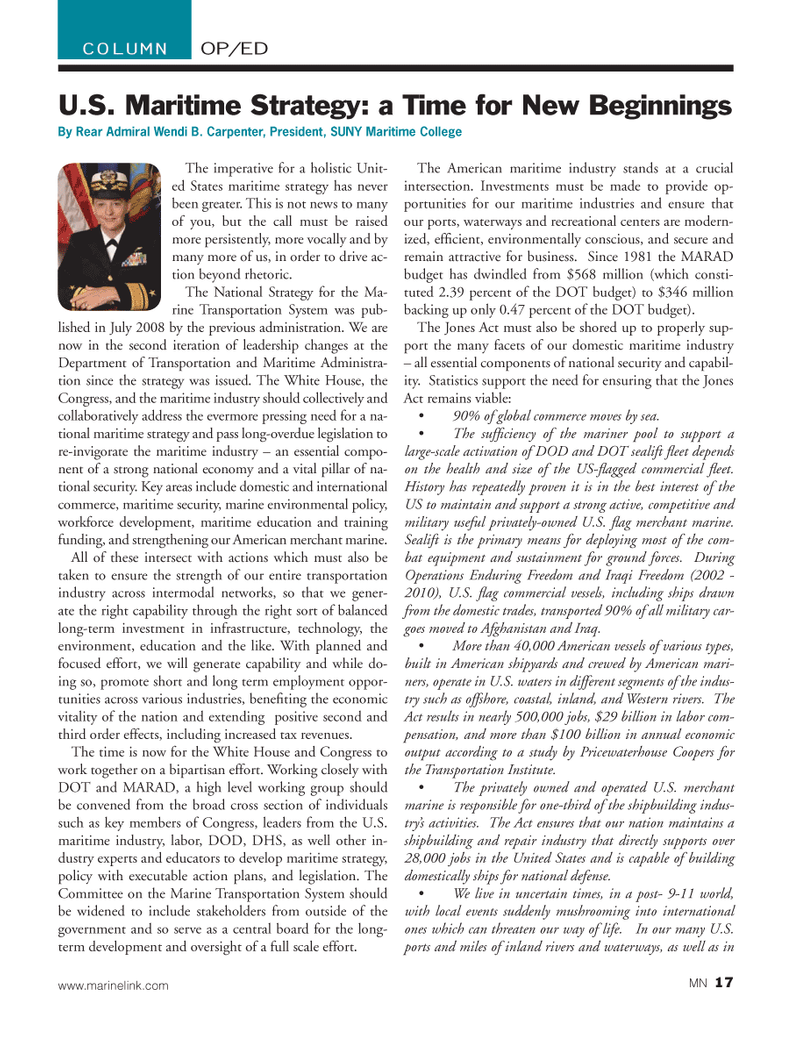
Page 17: of Marine News Magazine (July 2013)
Propulsion Technology
Read this page in Pdf, Flash or Html5 edition of July 2013 Marine News Magazine
The imperative for a holistic Unit- ed States maritime strategy has never been greater. This is not news to many of you, but the call must be raised more persistently, more vocally and by many more of us, in order to drive ac- tion beyond rhetoric. The National Strategy for the Ma- rine Transportation System was pub- lished in July 2008 by the previous administration. We are now in the second iteration of leadership changes at the Department of Transportation and Maritime Administra- tion since the strategy was issued. The White House, the Congress, and the maritime industry should collectively and collaboratively address the evermore pressing need for a na- tional maritime strategy and pass long-overdue legislation to re-invigorate the maritime industry ? an essential compo- nent of a strong national economy and a vital pillar of na- tional security. Key areas include domestic and international commerce, maritime security, marine environmental policy, workforce development, maritime education and training funding, and strengthening our American merchant marine. All of these intersect with actions which must also be taken to ensure the strength of our entire transportation industry across intermodal networks, so that we gener- ate the right capability through the right sort of balanced long-term investment in infrastructure, technology, the environment, education and the like. With planned and focused effort, we will generate capability and while do- ing so, promote short and long term employment oppor- tunities across various industries, bene? ting the economic vitality of the nation and extending positive second and third order effects, including increased tax revenues. The time is now for the White House and Congress to work together on a bipartisan effort. Working closely with DOT and MARAD, a high level working group should be convened from the broad cross section of individuals such as key members of Congress, leaders from the U.S. maritime industry, labor, DOD, DHS, as well other in- dustry experts and educators to develop maritime strategy, policy with executable action plans, and legislation. The Committee on the Marine Transportation System should be widened to include stakeholders from outside of the government and so serve as a central board for the long- term development and oversight of a full scale effort. The American maritime industry stands at a crucial intersection. Investments must be made to provide op- portunities for our maritime industries and ensure that our ports, waterways and recreational centers are modern- ized, ef? cient, environmentally conscious, and secure and remain attractive for business. Since 1981 the MARAD budget has dwindled from $568 million (which consti- tuted 2.39 percent of the DOT budget) to $346 million backing up only 0.47 percent of the DOT budget). The Jones Act must also be shored up to properly sup- port the many facets of our domestic maritime industry ? all essential components of national security and capabil-ity. Statistics support the need for ensuring that the Jones Act remains viable: ? 90% of global commerce moves by sea. ? The suf? ciency of the mariner pool to support a large-scale activation of DOD and DOT sealift ? eet depends on the health and size of the US-? agged commercial ? eet. History has repeatedly proven it is in the best interest of the US to maintain and support a strong active, competitive and military useful privately-owned U.S. ? ag merchant marine. Sealift is the primary means for deploying most of the com- bat equipment and sustainment for ground forces. During Operations Enduring Freedom and Iraqi Freedom (2002 - 2010), U.S. ? ag commercial vessels, including ships drawn from the domestic trades, transported 90% of all military car- goes moved to Afghanistan and Iraq. ? More than 40,000 American vessels of various types, built in American shipyards and crewed by American mari- ners, operate in U.S. waters in different segments of the indus- try such as offshore, coastal, inland, and Western rivers. The Act results in nearly 500,000 jobs, $29 billion in labor com- pensation, and more than $100 billion in annual economic output according to a study by Pricewaterhouse Coopers for the Transportation Institute. ? The privately owned and operated U.S. merchant marine is responsible for one-third of the shipbuilding indus- trys activities. The Act ensures that our nation maintains a shipbuilding and repair industry that directly supports over 28,000 jobs in the United States and is capable of building domestically ships for national defense.? We live in uncertain times, in a post- 9-11 world, with local events suddenly mushrooming into international ones which can threaten our way of life. In our many U.S. ports and miles of inland rivers and waterways, as well as in OP/EDCOLUMNU.S. Maritime Strategy: a Time for New Beginnings By Rear Admiral Wendi B. Carpenter, President, SUNY Maritime College www.marinelink.com MN 17MN July2013 Layout 1-17.indd 176/27/2013 12:58:49 PM

 16
16

 18
18
